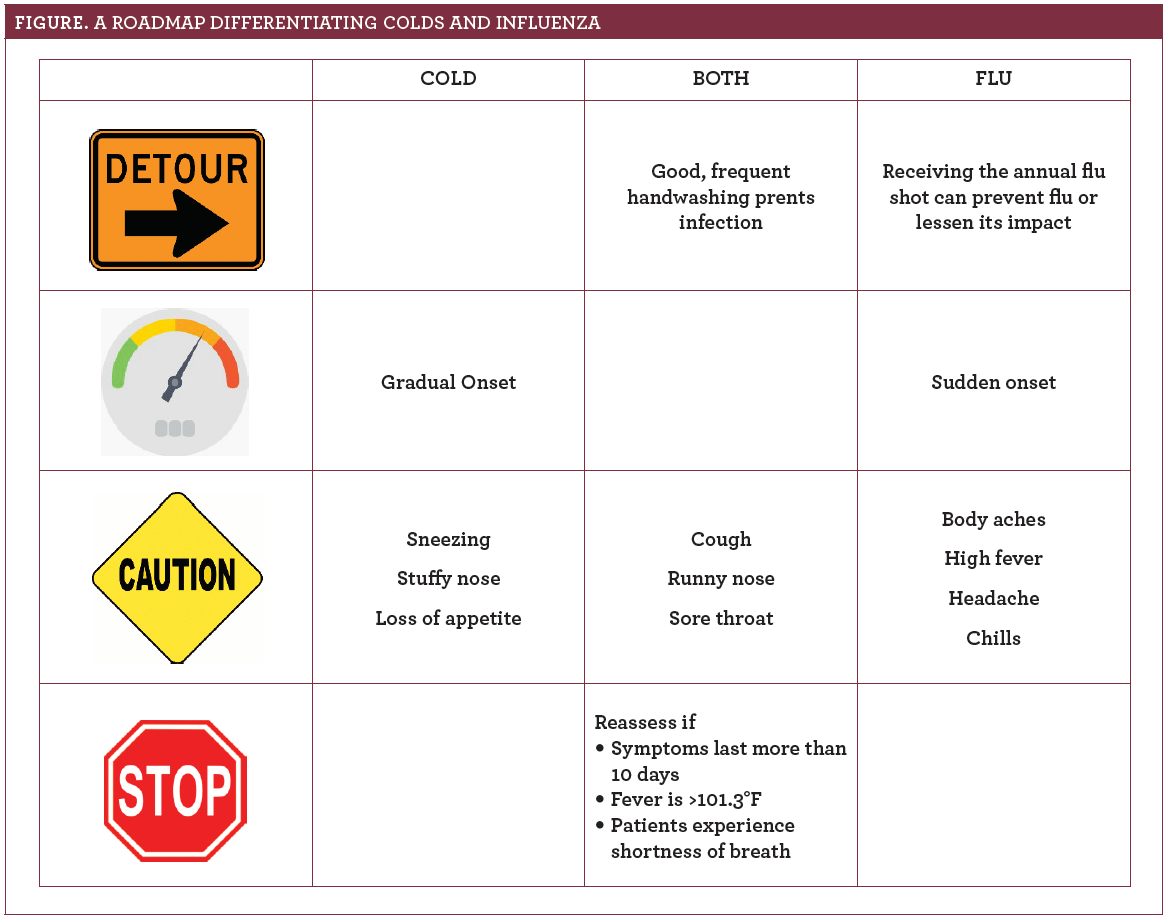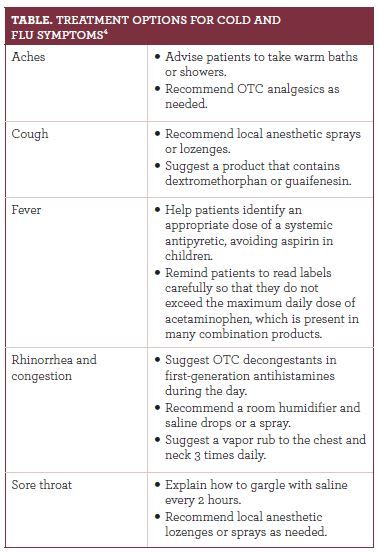Introduction to the Common Cold
Colds, coughs, and a relentless influx of sick patients in retail health clinics keep the health care providers who work there very busy.
It's that time of year again. Colds, coughs, and a relentless influx of sick patients in retail health clinics keep the health care providers who work there very busy. The most important thing to keep in mind is how to differentiate between the cold and the flu. TheFigureillustrates that both illnesses share some characteristics, but overall the flu is more sudden and severe.1Peak flu season is December through March, and if symptoms indicate the flu, consider treating with antivirals. Additionally, if patients who have either a cold or the flu experience symptoms for more than 10 days, have a fever ≥101.3°F, or develop shortness of breath, they need to return to the clinic.2

Education and Prevention
Patient education is one of the most important preventive measures for the common cold. Many individuals are not aware that cold-causing viruses can spread through personal contact, surfaces, and even the air. It is crucial to remind patients to wash their hands often with soap and water for 20 seconds and avoid touching their eyes, mouth, and nose with unwashed hands. They should also stay away from people who are obviously sick. Also advise those who do become sick to stay home and avoid contact with others, to decrease transmission.3
Another important counseling point: There is no cure for the common cold. Tired parents often demand antibiotics for their crying children, but remind them that antibiotics cannot treat a common cold, as it is a viral infection. Cutting down on unnecessary antibiotic use can help prevent bacterial resistance and keep patients safe.3
OTC Options
OTC treatment is the only option for symptom relief, and considering the vast array of available products, pharmacists’ guidance is essential. Before making any recommendation, remind patients who are excluded from self-treatment to see their doctors. TheTableprovides a straightforward guide to treatment selection.4

Congestion and rhinorrhea are often relieved with nasal sprays or saline drops. These are effective and safe options for those who do not want to use pharmacological treatment and in children of all ages. The American Academy of Pediatrics recommends vapor rubs as another option for children 2 years and older to lessen chest and nose congestion.6
OTC nasal and oral decongestants are other common products for treating congestion and rhinorrhea. Phenylephrine and pseudoephedrine are popular decongestants. Results from many studies have shown that pseudoephedrine is significantly more effective than phenylephrine and a placebo. Topical decongestants such as naphazoline, oxymetazoline, and tetrahydrozoline can also be used and have minimal adverse effects. Inform patients to use these products for only 3 to 5 days to prevent rebound congestion. Overall, decongestants are relatively safe, with oral routes tending to cause more adverse effects. Avoid recommending oral therapy to those taking monoamine oxidase inhibitors or who have hypertension, to prevent life-threatening rises in blood pressure.7
First-generation antihistamines, including diphenhydramine, can be used. Evidence shows that these effectively reduce rhinorrhea and sneezing associated with the common cold. Second-generation antihistamines, such as cetirizine (Zyrtec), fexofenadine (Allegra), levocetirizine (Xyzal), and loratadine (Claritin), however, are ineffective for these symptoms. The most common adverse effect of first-generation antihistamines is drowsiness, and patients should be counseled to take antihistamines at bedtime and to avoid concurrent alcohol or sedative use.8
Aches and fever respond to the OTC analgesics and antipyretics acetaminophen, ibuprofen, aspirin, and naproxen. Patients with active ulcers or an allergy to aspirin should avoid aspirin and other nonsteroidal anti-inflammatory drugs.7Warm baths or showers may also help ease aches.
A sore throat can be addressed temporarily by using products containing local anesthetics such as benzocaine and dyclonine. Recommend these topicals as lozenges, oral disintegrating strips, or throat sprays.9Saline gargles can also be useful.
A cough is a troublesome symptom that may diminish with the use of the anesthetics mentioned above. Pharmacists can also recommend an antitussive, such as dextromethorphan, for nonproductive coughs. In conflicting studies, investigators have found no strong evidence for or against its use in managing coughs.7
Guaifenesin, an expectorant, is another OTC product that may help patients with productive coughs. Its use is FDA approved, but again, studies have failed to find any evidence supporting its efficacy. The product is relatively safe, however, and can be recommended to patients as necessary.7
Nonpharmacological Options
For those who do not wish to use OTC products, consider home remedies, such as chicken soup, garlic, and ginger.10Honey is one of the only natural treatments that has been proved to be more effective than a placebo in reducing the frequency and severity of a nighttime cough.11Although these products’ effectiveness is unproven, these options may be worth recommending to give patients have some sense of control over their illnesses. In addition, increasing the humidity and the temperature in a room moistens the air and helps ease congestion.5
Conclusion
Patients seek treatment for the common cold, yet there is no cure. Pharmacists, as accessible health care professionals, must help guide them through the black hole that we call the cough and cold aisle. Education and prevention are also essential and should not be forgotten.
And stay tuned: Results from recent research suggest that a new, advanced technique could lead to a cure for the common cold. The drug would target human cells infected with the cold virus and inhibit its survival.12
Emily C. Hayes is a PharmD candidate at the University of Connecticut School of Pharmacy in Storrs.
References
- Cold vs. flu symptoms. Cone Health website. conehealth.com/services/primary-care/cold-vs-flu-symptoms/. Published January 26, 2018. Accessed October 22, 2018.
- Common cold. Mayo Clinic website. mayoclinic.org/diseases-conditions/common-cold/symptoms-causes/syc-20351605. Accessed October 22, 2018.
- Common colds: protect yourself and others. CDC website. cdc.gov/features/rhinoviruses/index.html. Updated February 12, 2018. Accessed October 22, 2018.
- Bartok V. The common cold: treatment algorithms.Pharmacy Times®website. pharmacytimes.com/publications/issue/2014/november2014/the-common-cold-treatment-algorithms. Published November 8, 2014. Accessed October 17, 2018.
- Korioth T. Simple remedies often best for common colds in young children.AAP Newswebsite.aappublications.org/content/32/12/32.5. Published November 27, 2011. Accessed October 17, 2018.
- Marjama K. Treating the common cold.Pharmacy Times®website. contemporaryclinic.pharmacytimes.com/journals/issue/2017/December2017/Treating-the-Common-Cold. Published December 29, 2017. Accessed October 22, 2018.
- Sutter AI, Lemiengre M, Campbell H, Mackinnon HF. Antihistamines for the common cold.Cochrane Database Syst Rev.2003;(3):CD001267.
- Terrie YC. Cough and cold products.Pharmacy Times®website. pharmacytimes.com/publications/issue/2009/november2009/otccoughcold-1109. Published November 15, 2009. Accessed October 22, 2018.
- Home remedies for common cold. Top 10 Home Remedies website. top10homeremedies.com/home-remedies/home-remedies-for-common-cold.html. Published April 5, 2018. Accessed October 22, 2018.
- Ashkin E, Mounsey A. PURLs: a spoonful of honey helps a coughing child sleep.J Fam Pract.2013;62(3):145-147.
- Common cold. Mayo Clinic website. mayoclinic.org/diseases-conditions/common-cold/diagnosis-treatment/drc-20351611. Accessed October 17, 2018.
- Newman T. The common cold: could we be close to a cure? Medical News Today website.medicalnewstoday.com/articles/321808.php. Published May 15, 2018. Accessed October 22, 2018.
Knock Out Aches and Pains From Cold
October 30th 2019The symptoms associated with colds, most commonly congestion, coughing, sneezing, and sore throats, are the body's response when a virus exerts its effects on the immune system. Cold symptoms peak at about 1 to 2 days and last 7 to 10 days but can last up to 3 weeks.
COPD: Should a Clinician Treat or Refer?
October 27th 2019The Global Initiative for Chronic Obstructive Lung Disease (GOLD) defines the condition as follows: “COPD is a common, preventable, and treatable disease that is characterized by persistent respiratory symptoms and airflow limitation that is due to airway and/or alveolar abnormalities usually caused by significant exposure to noxious particles or gases.â€
Diabetic Ketoacidosis Is Preventable With Proper Treatment
October 24th 2019Cancer, diabetes, and heart disease account for a large portion of the $3.3 trillion annual US health care expenditures. In fact, 90% of these expenditures are due to chronic conditions. About 23 million people in the United States have diabetes, 7 million have undiagnosed diabetes, and 83 million have prediabetes.
What Are the Latest Influenza Vaccine Recommendations?
October 21st 2019Clinicians should recommend routine yearly influenza vaccinations for everyone 6 months or older who has no contraindications for the 2019-2020 influenza season starting at the end of October, according to the Advisory Committee on Immunization Practices.
What Is the Best Way to Treat Pharyngitis?
October 18th 2019There are many different causes of throat discomfort, but patients commonly associate a sore throat with an infection and may think that they need antibiotics. This unfortunately leads to unnecessary antibiotic prescribing when clinicians do not apply evidence-based practice.

